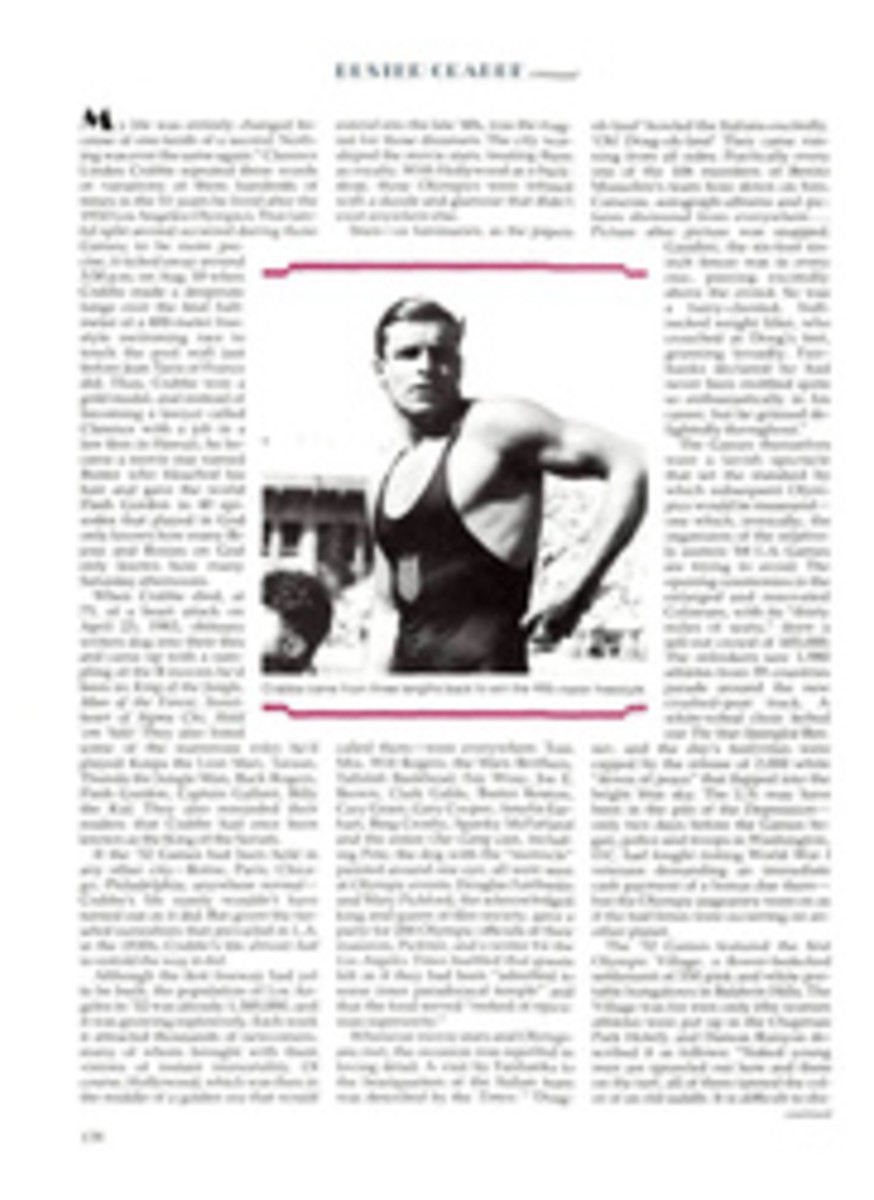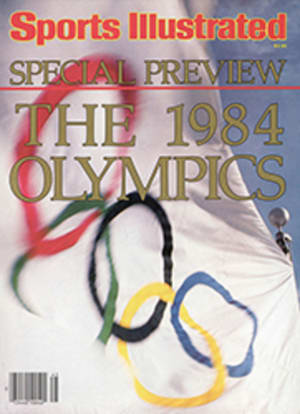
Getting Into The Swirl
It isn't often—indeed, it's almost never—that one gets to use the word voluptuous in a sober report on the Olympics. But it's just the right adjective for rhythmic gymnastics, which, along with synchronized swimming, is one of the two new sports on the schedule in Los Angeles. The sinuously curved leg, the subtle nuance of a properly arched back—these sorts of things are the essence of rhythmic gymnastics. Oh, irate purists are going to scream that, if it's this pretty, it sure ain't sport, but the truth is, rhythmic gymnastics will provide just the right elegant counterpoint to the rest of the Games.
It's important to note right off that rhythmic sportive gymnastics—as it's officially known—is a blood relative of the more familiar artistic gymnastics, of the vault and bars and beam. Both have been around for a long time, rhythmic since the 18th century. Maybe the best way to distinguish between the two is to remember that, aside from the floor exercise, artistic gymnasts perform on equipment and rhythmic gymnasts (women exclusively) perform with it. But the heck with technicalities for a moment—the thing to do here is to leap right ahead to a rhythmic gymnast and her magic ribbon.
The ribbon in question is a two-inch-wide heavy satin strip, 19'8¼" long, connected to a slender wooden wand. The gymnast marches pertly out on the floor with the ribbon trailing obediently behind, as if she were taking it for a walk. She begins her routine supine on the mat, one arm outstretched above her head. The music starts: Stirred by all but imperceptible movements of her hand, the ribbon suddenly appears to take on a life all its own, snaking and undulating seductively in increasingly wide spirals. And then the gymnast is up and dancing acrobatically, while the strip of satin spins, arcs and twirls in accompaniment. During the 60-to-90-second program, the two elements, the woman and her ribbon, work together as one, through stag leaps, plies and dizzying spins. The ribbon is used to italicize the movements of the gymnast, to accent every motion, and the eye sees not the woman or the ribbon, but both, as a unit, in a single flowing composition.
The same is true of the other equipment used in rhythmic gymnastics: a 14-ounce, eight-inch plastic or rubber ball, a 32-to-36-inch wood or plastic hoop and two 16-to-18-inch-long Indian clubs that weigh five to eight ounces apiece. Indeed, working with the ball, any rhythmic gymnast worth her leotard would make a Harlem Globetrotter look like a klutz. She spins it deftly, tosses it high into the lights and makes spectacular behind-the-back, upside-down, in-her-face catches, all the while doing a floor exercise full of verve. She even rolls across the floor on top of the ball—something we never saw old Meadowlark Lemon do. (There's a fifth piece of equipment, a jump rope varying in length according to the height of the gymnast, but that one won't be in the L.A. Olympics.)
Technically, rhythmic gynmastics isn't a new Olympic sport. Some female Olympic gymnasts from 1948 to '56 competed with rhythmic equipment, in group routines as well as on apparatus. Then in 1956 the Federation of International Gymnastics decided to separate the sport into two disciplines, and rhythmic has been struggling to get back into the Olympics ever since. Finally, at an International Olympic Committee meeting before the 1980 Games, they succeeded, and will return this year as a separate event.
For the U.S., this is occurring at least four years too soon. America's rhythmic gymnasts are eager but not quite ready. As their coach says, "These girls represent our first generation in the sport."
Ah, the coach. She's one Alla Svirsky, a tiny whirlwind of a woman, at once gruff and charming, endlessly persuasive, the principal force in pushing the sport to maturity in the U.S. Svirsky was a belle of the ball—and the clubs and the ribbon, etc.—as a member of the Soviet national team from 1960 to '63. She was later her club's all-around champ and then head coach at the Polytechnical Institute and the famed Lokomotive Club in Odessa, all of which earned her the rank of Master of Sport. She also holds two master's degrees, one in physical education, the other in anatomy and physiology. "It was dissecting all those dead bodies that taught me how muscles really work in gymnastics," she says sweetly. Svirsky emigrated to Los Angeles in '74 and was artistic gymnastics coach at USC for five years; during that time Southern Cal's team went from 19th to fifth in the country. She became a citizen in '79.
Thirteen of the 24 U.S. national rhythmic team members are Svirsky's students at the Los Angeles School of Gymnastics, where she became the first coach upon leaving USC. When she's not coaching them, she's off seeking sponsorship money, cajoling, begging, barking at people in a Russian accent right out of an old Preston Sturges comedy. "So many times I told you: You see my girls, you'll love this sport," she says. "You vant a demonstration? Ve give. Ve do conventions. Banquets. Ve go anyvhere. Ve dance in your parking lot to raise money for U.S. team. Look, you see dot movie Flashing Dance? Vhere the girl spins around the floor on her back? Veil, that's my move; I originated it. As much as anything, it demonstrates the lively style of U.S. team."
There's no question about the U.S. Olympic entry being lively; the problem is that so much of the rest of the world is far beyond lively. "In Europe," says Svirsky, "there are routinely 6,000 girls seeking to get on each national team."
At the 11th world championships in Strasbourg, France last November, Bulgaria blew everyone away, finishing first in all four categories. The best American was U.S. champion Michelle Berube of Rochester, Mich., who struggled in an honorable 34th.
It figures that a sport so exotic relies on artistry over athletics: The competitors are judged on originality of routine and its execution. Gestures, even facial expressions, count. The hot tip for the Olympics is that many of the Eastern Europeans have been trying to adopt an impish mien, and since they're so widely copied, we can expect to see an awful lot of impishness at Pauley Pavilion. Wild flips and other highly acrobatic moves are out—that vigorous stuff is for the other type of gymnasts and can actually cost points.
There are no compulsories in rhythmic gymnastics, but in regular meets, somewhere in each routine there must be two moves recognized as superior by the IGF and six deemed medium in difficulty. For the Olympics, three superior elements will be required.
That's not the only change made for the Games. In fact, what will be seen in L.A. might be called the Great Distillation. There will be no medals for excellence with the individual pieces of equipment and no team competition. Only two women from each of the competing nations can battle it out in the all-around; the three top scorers after all four events are completed will win the medals. On the first two evenings, the competitors will perform to determine a field cut to the top 20 for the Aug. 11 finals, in which the survivors will perform with all four pieces of equipment. Until the pullout of countries such as Bulgaria, the U.S.S.R. and East Germany, just making the final cut would have been a triumph for the U.S. Now Svirsky even dares to think of a medal.
"Ve all do the best ve can," she said recently, tearing off to still another fund-raising appointment. Last March her gymnasts did two demonstrations for McDonald's, the hamburger folks, to get a $1,250 donation. The second came after a company awards banquet staged in a ballroom above a delicatessen-restaurant. The young girls resolutely worked with all their equipment while the rich, heavy smells of corned beef and pastrami swirled around them. "And, as everybody knows," says Svirsky, "gymnasts aren't allowed to eat anything. They got to stay skinny and supple. Me, I'm starved."
Thus does a sport grow.
PHOTO
TWO PHOTOS
U.S. team coach Svirsky gets a big kick out of saying she invented a move used in that noted movie "Flashing Dance."
PHOTO
The rope is the rhythmic device going unused in L.A.

